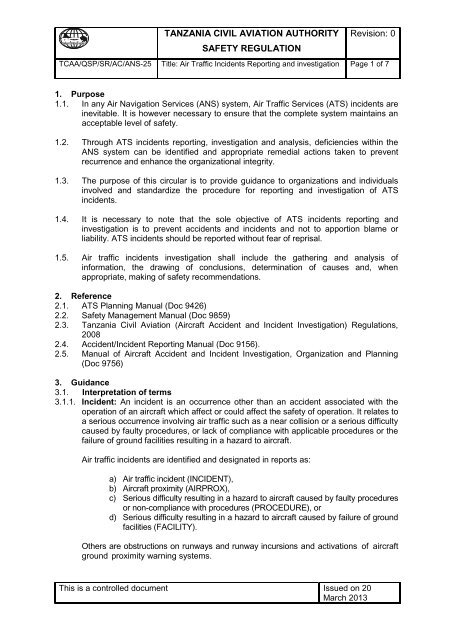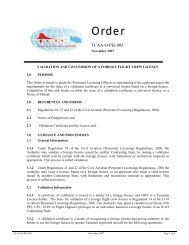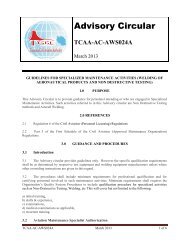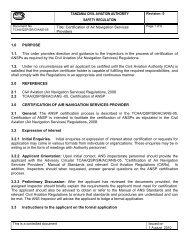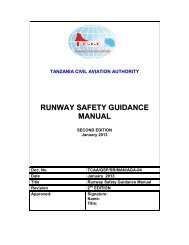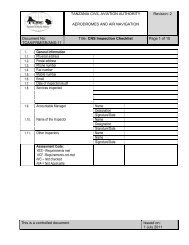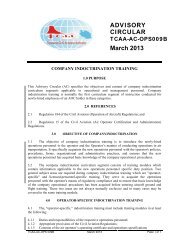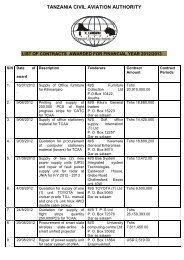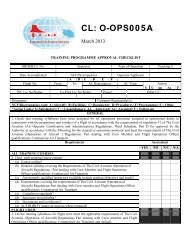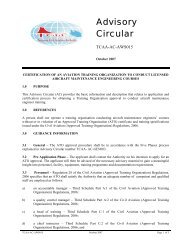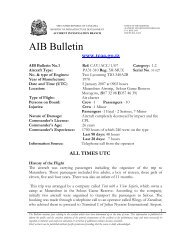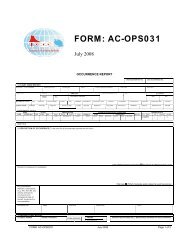ATS incidents reporting, investigation - Tanzania Civil Aviation ...
ATS incidents reporting, investigation - Tanzania Civil Aviation ...
ATS incidents reporting, investigation - Tanzania Civil Aviation ...
- No tags were found...
You also want an ePaper? Increase the reach of your titles
YUMPU automatically turns print PDFs into web optimized ePapers that Google loves.
TANZANIA CIVIL AVIATION AUTHORITY Revision: 0SAFETY REGULATIONTCAA/QSP/SR/AC/ANS-25 Title: Air Traffic Incidents Reporting and <strong>investigation</strong> Page 1 of 71. Purpose1.1. In any Air Navigation Services (ANS) system, Air Traffic Services (<strong>ATS</strong>) <strong>incidents</strong> areinevitable. It is however necessary to ensure that the complete system maintains anacceptable level of safety.1.2. Through <strong>ATS</strong> <strong>incidents</strong> <strong>reporting</strong>, <strong>investigation</strong> and analysis, deficiencies within theANS system can be identified and appropriate remedial actions taken to preventrecurrence and enhance the organizational integrity.1.3. The purpose of this circular is to provide guidance to organizations and individualsinvolved and standardize the procedure for <strong>reporting</strong> and <strong>investigation</strong> of <strong>ATS</strong><strong>incidents</strong>.1.4. It is necessary to note that the sole objective of <strong>ATS</strong> <strong>incidents</strong> <strong>reporting</strong> and<strong>investigation</strong> is to prevent accidents and <strong>incidents</strong> and not to apportion blame orliability. <strong>ATS</strong> <strong>incidents</strong> should be reported without fear of reprisal.1.5. Air traffic <strong>incidents</strong> <strong>investigation</strong> shall include the gathering and analysis ofinformation, the drawing of conclusions, determination of causes and, whenappropriate, making of safety recommendations.2. Reference2.1. <strong>ATS</strong> Planning Manual (Doc 9426)2.2. Safety Management Manual (Doc 9859)2.3. <strong>Tanzania</strong> <strong>Civil</strong> <strong>Aviation</strong> (Aircraft Accident and Incident Investigation) Regulations,20082.4. Accident/Incident Reporting Manual (Doc 9156).2.5. Manual of Aircraft Accident and Incident Investigation, Organization and Planning(Doc 9756)3. Guidance3.1. Interpretation of terms3.1.1. Incident: An incident is an occurrence other than an accident associated with theoperation of an aircraft which affect or could affect the safety of operation. It relates toa serious occurrence involving air traffic such as a near collision or a serious difficultycaused by faulty procedures, or lack of compliance with applicable procedures or thefailure of ground facilities resulting in a hazard to aircraft.Air traffic <strong>incidents</strong> are identified and designated in reports as:a) Air traffic incident (INCIDENT),b) Aircraft proximity (AIRPROX),c) Serious difficulty resulting in a hazard to aircraft caused by faulty proceduresor non-compliance with procedures (PROCEDURE), ord) Serious difficulty resulting in a hazard to aircraft caused by failure of groundfacilities (FACILITY).Others are obstructions on runways and runway incursions and activations of aircraftground proximity warning systems.This is a controlled document Issued on 20March 2013
TANZANIA CIVIL AVIATION AUTHORITYSAFETY REGULATIONRevision: 0TCAA/QSP/SR/AC/ANS-25 Title: Air Traffic Incidents Reporting and <strong>investigation</strong> Page 2 of 7Air operators and pilots are, in addition required to report <strong>incidents</strong> involvingactivations of aircraft ground proximity warning systems so that their locations canbe identified and altitude, routing and/or aircraft operating procedures altered toprevent recurrences.3.1.2. Aircraft proximity: Aircraft proximity is a situation in which, in the opinion of a pilotor air traffic services personnel, the distance between aircraft as well as their relativepositions and speeds have been such that the safety of the aircraft involved mayhave been compromised.Aircraft proximity is classified as follows:a) Risk of collision: Serious risk of collision has existed.b) Safety not assured: The safety of the aircraft may have beencompromised.c) No risk of collision: No risk of collision has existed.d) Risk not determined: Insufficient information was available to determinethe risk involved, or inconclusive or conflicting evidence precluded suchdetermination.3.1.3. AIRPROX: AIRPROX is the abbreviation used in an air traffic incident report todesignate aircraft proximity.3.2. Reporting procedure3.2.1. Air traffic <strong>incidents</strong> are often reported through <strong>ATS</strong> air‐ground-air communicationchannels. Such reports and any associated information shall be recorded by the unitconcerned in the log book and immediately brought to the notice of the ATM In-Charge. Any air traffic incident known to have occurred shall be treated like thosereported by pilots.3.2.2. The supervisor shall provide relief to the controller who was involved in <strong>ATS</strong> incidentas promptly as operational and staffing conditions permit. This action will allow thecontroller involved the opportunity to prepare statements while the circumstances arestill fresh in their minds.3.2.3. All <strong>ATS</strong> <strong>incidents</strong> shall be reported to the Director of Safety Regulation by the fastestmeans of communication available using the prescribed format.3.2.4. The air traffic incident report form shall be used when submitting or receiving airtraffic <strong>incidents</strong>. The purpose of the form is to provide investigatory authorities with ascomplete information as possible on an air traffic incident.The <strong>ATS</strong> incident report form is intended for use by:a) a pilot for filing a report on an air traffic incident after arrival or to confirm areport made by radio;b) an <strong>ATS</strong> unit for recording an air traffic incident report received by radio ortelephone3.2.5. Reporting by pilots3.2.5.1. A pilot involved in an incident shall proceed as follows:This is a controlled document Issued on 20March 2013
TANZANIA CIVIL AVIATION AUTHORITY Revision: 0SAFETY REGULATIONTCAA/QSP/SR/AC/ANS-25 Title: Air Traffic Incidents Reporting and <strong>investigation</strong> Page 3 of 7a) during flight, use the appropriate air/ground frequency for <strong>reporting</strong> anincident of major significance, particularly if it involves other aircraft, so asto permit the facts to be ascertained immediately;b) as promptly as possible after landing submit a completed air trafficincident report form:i) for confirming a report of an incident made using air/groundfrequency, or for making the initial report on such an incident if ithad not been possible to report it by radio; andii) for <strong>reporting</strong> an incident which did not require immediatenotification at the time of occurrence3.2.5.2. An initial report made by radio should contain the following information:a) type of incident, e.g. near collision;b) radio call sign of aircraft making report;c) position, heading or route and true airspeed;d) flight level, altitude or height and aircraft attitude;e) flying conditions (e.g. IMC or VMC);f) time of incident in UTC;g) description of other aircraft, if relevant; andh) brief details of incident, including, when appropriate, sighting distance andmiss distance3.2.5.3. The air traffic incident initially reported by radio should be submitted by the pilot tothe <strong>ATS</strong> <strong>reporting</strong> office of the aerodrome of first landing using the appropriate form.The pilot should complete sections 1 and 2 supplementing the details of the radioreport as necessary.Where there is no <strong>ATS</strong> <strong>reporting</strong> office, the report may be submitted to any other<strong>ATS</strong> unit or the Authority through the most expeditious means.3.2.6. Reporting by <strong>ATS</strong>3.2.6.1. Following an air traffic incident the ATC unit involved shall proceed as follows:a) designate the incident in accordance with the procedure detailed in 3.1.1and 3.1.2;b) if the aircraft is bound for a destination located within the area ofresponsibility of the <strong>ATS</strong> unit in whose area the incident occurred,arrangements should be made with the operator to obtain the pilot’s reporton landing;c) if the aircraft is bound for a domestic destination, the <strong>ATS</strong> unit ofdestination should be requested to obtain the pilot’s report on landing;d) if the aircraft is bound for an international destination, the <strong>ATS</strong> authority atdestination aerodrome should be notified and given full details of theincident (by AFTN) and requested to obtain the pilot’s report;e) if the incident involves another aircraft, similar action should be taken inregard to both parties;f) complete the air traffic incident form; andg) ensure that the Authority is notified of all reportable <strong>incidents</strong>This is a controlled document Issued on 20March 2013
TANZANIA CIVIL AVIATION AUTHORITY Revision: 0SAFETY REGULATIONTCAA/QSP/SR/AC/ANS-25 Title: Air Traffic Incidents Reporting and <strong>investigation</strong> Page 4 of 7Note: Notification of other interested parties including other <strong>Civil</strong> <strong>Aviation</strong>Authorities, operators, State of registry etc shall be made by the Authority.3.2.6.2. Air Traffic Services shall ensure that all incident reports are filed as soon aspossible after occurrence and preliminary <strong>investigation</strong> conducted while the subjectis still fresh in minds and records available.3.2.7. Initial action by the <strong>ATS</strong> unit involved3.2.7.1. Immediately following an air traffic incident all documents (log books, flight progressstrips, meteorological reports/forecasts etc.) and recordings (VHF/Radiotransmissions, intercom, telephone communications etc.) relating to the <strong>incidents</strong>hall be impounded and clearly marked for <strong>investigation</strong> purposes.3.2.7.2. The ATM-in-Charge shall compile and submit a preliminary report of the incident tothe Director of Safety Regulation through appropriate channels under confidentialcover within ten working days following the occurrence of the incident. Thepreliminary report shall contain prima facie facts and shall include the following;a) details of aircraft involved (call sign, type, registration marking, operatorand place of departure & destination);b) names and operating positions of <strong>ATS</strong> personnel involved;c) full details of the sequence of events in narrative form;d) statements by personnel involved;e) transcript of relevant voice recordings and telephone communication;f) copies of flight progress strips and other flight data, including graphicalpresentation of radar data; andg) copies of meteorological reports and forecast relevant to the time of theincidenth) technical statements concerning the operating status of equipment, ifapplicableThe Authority shall conduct an independent <strong>investigation</strong> on all <strong>incidents</strong>.3.2.7.3. The Air Navigation Services Provider (ANSP) shall conduct its <strong>investigation</strong> andsubmit a report to the Authority. The findings and recommendations in the reportshall be consideration by the Authority as appropriate.3.3. Investigation and documentation3.3.1. It is essential to determine the cause of an air traffic incident, with the minimum delayso that action can be taken to prevent recurrence. To give effect to the air trafficincident investigating process, an investigating team shall be established by the DSR.The team shall include <strong>ATS</strong> experts and other specialist officers from flightoperations, telecommunications engineering or other fields, if required. In additionand when necessary, the controller(s) involved in the incident should be given theopportunity to nominate as a member of the team an experienced controller of equalgrade as a representative during the <strong>investigation</strong>.3.3.2. Should the pilot, the operator or a civil aviation authority refuse to provide informationnecessary for the proper <strong>investigation</strong> of an air traffic incident, the <strong>investigation</strong>should precede using available information. The Authority shall take enforcementactions against defaulters.This is a controlled document Issued on 20March 2013
TANZANIA CIVIL AVIATION AUTHORITY Revision: 0SAFETY REGULATIONTCAA/QSP/SR/AC/ANS-25 Title: Air Traffic Incidents Reporting and <strong>investigation</strong> Page 5 of 73.3.3. The proceedings of an air traffic incident investigating team, as well as papers andrecords used by it should be treated as confidential material. Specific prima faciefacts required by the team should be prepared by the unit and should include, asappropriate:a) names and operating positions of involved <strong>ATS</strong> personnel;b) full details of the sequence of events in narrative form;c) names of pilots and operating companies and details of aircraft involved;d) reports from controllers involved as prepared before leaving the unit onthe day of the occurrence;e) reports from pilots involved, if possible as prepared at the next point oftouch-down, preferably in pen script but acceptable by AFTN signal and, ifnecessary, through the operator’s office;f) the marking and impounding of relevant voice recording tapes, flightprogress strips and other flight data including recorded radar data ifavailable3.3.4. The report of the <strong>ATS</strong> incident <strong>investigation</strong> committee should include a summary ofthe incident and the cause. The report should contain all relevant information, inchronological sequence where appropriate, and concluding with a list of findings,conclusions, causes and safety recommendations for the purpose ofaccident/incident prevention. Recommended corrective actions should also beincluded in the report. The committee should not make recommendations onpersonnel or disciplinary action in the event of controller error because thefundamental objective of the <strong>investigation</strong> is prevention of accidents, not to apportionblame or liability.3.3.5. The following information should be submitted as appendices to the report:a) statements by personnel involved;b) tape transcripts of relevant air-ground and telephone communications;c) copies of meteorological reports or forecasts relevant to the incident;d) copies of flight progress strips and other data relevant to the incident,including recorded radar data, if available;e) any technical statements concerning the operating status of equipment, ifapplicable3.3.6. On completion of the <strong>investigation</strong>, full details of the findings should be sent throughappropriate channels to the pilot, and/or the operator and the civil aviation authority ofthe State in which the aircraft is registered.3.4. Analysis of <strong>ATS</strong> <strong>incidents</strong>3.4.1. The analysis of an incident should be considered in relation to system operation andhave regard to factors such as the following:a) Procedures - Were the procedures and separation standards appliedcorrectly for the situation?b) Data and display - Was the displayed data correct and complete in termsof local unit instructions? Was the displayed information properlyinterpreted and utilized?This is a controlled document Issued on 20March 2013
TANZANIA CIVIL AVIATION AUTHORITY Revision: 0SAFETY REGULATIONTCAA/QSP/SR/AC/ANS-25 Title: Air Traffic Incidents Reporting and <strong>investigation</strong> Page 6 of 7c) Co-ordination - Were the prescribed co-ordination procedures adequateand correct and were they correctly and fully applied?d) Communication - Was correct phraseology used by all personnelinvolved? Was there any failure to communicate clearly and conciselywhich may have given rise to error or misunderstanding? Was there anyfailure to note and correct any incorrect read back of information? Wasthere any failure to obtain acknowledgement of the receipt of information?e) Equipment - Was the performance of relevant technical equipmentadequate? (if any failure or malfunction of equipment caused orcontributed to the incident, specialized technical advice or evidenceshould be sought)f) Personnel performance - Were any factors present which may haveaffected an individual’s performance, e.g. fatigue, illness, personalproblems, etc.? (While personnel errors may be established by thecommittee, degrees of negligence, carelessness or blame are not to bespecified)g) Task environment - All aspects of the working environment should beconsidered which may have affected the performance of personnel, e.g.background noise, heating, ventilation, ambient light levels, etch) General operations - Were all personnel familiar with the traffic situationand pertinent data before assuming responsibility for an operatingposition? Were the duties and responsibilities for the operating position(s)clearly defined? The adequacy of staffing in relation to traffic densityshould be considered as well as relief, and adequate rest periods. Ifapplicable, was the level of supervision satisfactory?3.4.2. Once the analysis of an <strong>ATS</strong> incident has been completed, information on the results,including conclusions and recommendations reached, should be made available to allconcerned so that corrective actions, etc. may be taken and all concerned are fullyaware of the final results.3.5. Release of information3.5.1. In the interest of accident and incident prevention, the <strong>investigation</strong> report should bepublished as soon as possible. When it is considered that disclosure of records,described below might have an adverse effect on the availability of information in that<strong>investigation</strong> or any future <strong>investigation</strong>, then such records shall not be madeavailable. Such records include:a) statements from persons responsible for the safe operation of the aircraft;b) communications between persons having responsibility for the safeoperation of the aircraft;c) medical or private information regarding persons involved;d) cockpit voice recordings and transcripts from such recordings;e) opinions expressed in the analysis of information, including flight recorderinformation3.5.2. Members of the press and general public who make inquiries into occurrences shouldbe referred to a person authorized to release information3.6. Incident <strong>reporting</strong> systemsThis is a controlled document Issued on 20March 2013
TANZANIA CIVIL AVIATION AUTHORITY Revision: 0SAFETY REGULATIONTCAA/QSP/SR/AC/ANS-25 Title: Air Traffic Incidents Reporting and <strong>investigation</strong> Page 7 of 73.6.1. The Authority shall establish a mandatory incident <strong>reporting</strong> system to facilitatecollection of information on actual or potential safety deficiencies and a voluntaryincident <strong>reporting</strong> system to facilitate collection of information on actual or potentialsafety deficiencies that may not be captured by the mandatory incident <strong>reporting</strong>system.3.6.2. Other safety data collection and processing systems shall also be established tocollect safety information that may not be captured by the mandatory and voluntary<strong>reporting</strong> systems.3.6.3. A voluntary incident <strong>reporting</strong> system shall be non-punitive and afford protection tothe sources of the information. The non-punitive culture is fundamental to voluntary<strong>reporting</strong>. ANSPs are encouraged to facilitate and promote the voluntary <strong>reporting</strong> ofevents that could affect aviation safety.<strong>Tanzania</strong> <strong>Civil</strong> <strong>Aviation</strong> AuthorityThis is a controlled document Issued on 20March 2013


